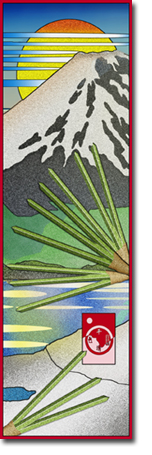On The Way: The Daily Zen Journal
Calming the Mind
Tao-shin (580-651)
The fundamental teachings of mine are – the mind of all the Buddhas is the First Principle, based on the Lankavatara Sutra, and i-hsing san-mei means that the mind which is aware of the Buddha is the Buddha, whereas the mind which does false thinking is the ordinary person, based on the Wen shu shuo po jo ching which says:
Manjusri asked the World Honored One the meaning of i-hsing san-mei. The Buddha replied: “Ultimate reality has a unified form (i-hsing). Fixing your awareness on ultimate reality is called i-hsing san-mei. If sons and daughters of noble families want to enter i-hsing san-mei, they should first listen to the Perfection of Wisdom teaching and cultivate practice in terms of what it says.
“Later they will be able to enter i-hsing san-mei, and their awareness will be like ultimate reality: free from retrogression, indestructible, inconceivable, lacking obstructions, and without form. Sons and daughters of noble families who want to enter into i-hsing san-mei but cannot, should enter into an enclosure empty of distractions and give up all chaotic thoughts.
“Without grasping onto outward appearances, they should concentrate their minds on a particular Buddha and exclusively recite his name. By properly facing in the direction of the Buddha, having an upright body, and being able to continuously think on one Buddha thought after thought, means that in this contemplation they are able to see all the Buddhas of the past, present, and future.
“Contemplating the measurelessness and boundlessness of the merit of one Buddha is the same as the merit of countless Buddhas since they are non-dualistic and inconceivable. The Buddha’s Dharma is without distinctions. Everything conforms to the One True Suchness to achieve the most perfect realization. Therefore, everyone will attain unlimited merit and unlimited abilities. Those who enter i-hsing san-mei in this way exhaustively know ultimate reality and the undifferentiated forms of Buddhas as numerous as the sands of the Ganges.”
Every aspect of the mind and body, even lifting your foot and putting it down, always is the place of enlightenment. All of your behavior and actions are enlightenment.
The P’u hsien kuan ching says: “The sea of all karmic hindrances totally arises from false thinking. Those who desire to repent should sit upright and contemplate true reality.”
This is called Repentance according to the first principle, which eradicates the mind of the three poisons, the grasping mind, and the conceptualizing mind. If one continuously meditates on Buddha thought after thought, suddenly there will be clarity and serenity, and still further, not even an object of thought.
The Ta p’in ching says: “No object of thought means to be thinking on Buddha.”
Why is it called wu-sui-nien? It means the mind which is “thinking on Buddha” is called thinking on no object (wu-sui-nien). Apart from mind there is no Buddha at all. Apart from Buddha there is no mind at all. Thinking on Buddha is identical to the thinking mind. To seek the mind means to seek for the Buddha.
Why is this? Consciousness is without form. The Buddha lacks any outer appearance. When you understand this truth, it is identical to calming the mind. If you always are thinking on Buddha, grasping does not arise, and everything disappears and is without form, and thinking is impartial without discrimination. To enter into this state, the mind which is thinking on Buddha disappears, and further it is not even necessary to indicate the mind as Buddha.
When you see this, your mind is none other than the body of the real and true nature of the Tathagata. It is also called the True Dharma; it is also called Buddha Nature; it is also called the Real Nature or Real Ultimate of the various dharmas; it is also called the Pure Land; it is also called enlightenment; the Diamond Samadhi, and original enlightenment; it is also called the realm of nirvana and wisdom. Although the names are innumerable they are all the same One Essence and do not mean a subject of contemplation nor an object of contemplation.
When the mind is impartial like this, without fail it is made clear and pure and always appears in front of you so that the various conditions are not able to become obstructive. Why is this? Because all these phenomena are the body of the One Dharma of the Tathagata.
When one stays in the unified mind, all bondage and illusion spontaneously disappear. Within a single speck of dust are all innumerable realms. Innumerable realms are collected on the tip of a single hair. Because their original nature is suchness, there is not any mutual interference. The Hua yen ching says: “There is one volume of scripture explaining that ‘in a single speck of dust one can see the phenomena of 3000 chilocosms.'” As briefly pointed out, it is impossible to exhaust everything when it comes to describing the methods for calming the mind. In this, skillfulness comes from the heart.
Tao-shin (580-651)





“Every aspect of the mind and body, even lifting your foot and putting it down, always is the place of enlightenment. All of your behavior and actions are enlightenment.”
With all the journals there are always one or two sentences that jump out at us. They seem to be what the piece turns on for us here and now. This is a very ancient work, and it is interesting how much is conveyed in this excerpt. Early on there was not much direct instruction regarding meditation, and yet here we find several suggestions one could build a practice around.
However, in that sentence above one can feel the impact of us carrying out the Dharma in our very action. It makes you stop to realize that each one of us is the current manifestation of turning the wheel in our daily lives. It is not “Someday when I have time…” or “I’ve never had a big enlightenment experience like the Zen masters…” It is all currently sitting, literally, in our laps. There is no one overseeing our daily life practice; it rests on our shoulders. Sort of makes you pause…
” …the mind which is aware of the Buddha is the Buddha…”
Each time we think then of the Buddha; each time we look at a statue of the Buddha; each time we recite the name; “… grasping does not arise, and everything disappears and is without form, and thinking is impartial without discrimination.”
May it be so,
Elana, Scribe for Daily Zen